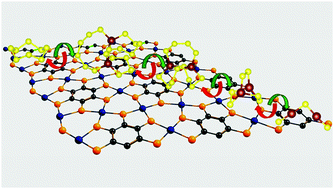Superior anchoring effect of a Cu-benzenehexathial MOF as an aluminium–sulfur battery cathode host†
Abstract
The poor reversibility and short lifespan of next generation Al–S batteries can be effectively overcome by opting for a cathode host able to trap sulfur and Al polysulfide species. In this work, with the help of density functional theory (DFT) calculations, a 2D Cu-benzenehexathial (Cu-BHT) metal organic framework (MOF) has been proposed as an excellent potential cathode host for Al–S batteries as compared to carbonaceous hosts such as graphene. The favourable electrical conductivity of the Cu-BHT MOF eliminates the insulating nature of most sulfur-based electrodes and is helpful in supporting the cathode charge/discharge processes. The results of a binding study show that while graphene has low binding energies (−0.76 to −0.88 eV) towards Al polysulfides, the Cu-BHT MOF exhibits improved binding to Al polysulfides (−1.11 to −3.56 eV) because of the presence of copper and sulfur, which results in increased charge transfer to the Al polysulfides. The synergic dual interactions based on the Al–S (of the sulfur host) bond and S (of the Al polysulfide)–Cu bond also lead to a uniform deposition of insoluble Al2S3 over the Cu-BHT surface, improving the utilization of the active cathode host. This leads to the incorporation of 45.81 wt% sulfur in the Cu-BHT monolayer host, higher than that of the experimentally reported S@HKUST-1-C cathode host (34 wt%) for Al–S batteries. Moreover, it is also observed that the Al polysulfide binding is much stronger than their interaction with the electrolytes, thus decreasing the overall dissolution of Al polysulfides into the electrolyte and improving the net cycling performance in Al–S batteries. With these desirable properties, it is expected that the Cu-BHT MOF can be used as a promising anchoring cathode host compared to graphene in Al–S batteries.



 Please wait while we load your content...
Please wait while we load your content...